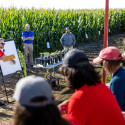New storage method amplifies cells available for science
Like many other kinds of cells used in biomedical research, human embryonic stem cells are stored and transported in a cryopreserved state, frozen to -320 degrees Fahrenheit, the temperature of their liquid nitrogen storage bath.
But when scientists thaw the cells for use in the lab, less than 1 percent awake from their frigid slumber and assume their undifferentiated state. This ‘blank slate’ form is characteristic of stem cells and essential for the basic science required before the promising cells are ready for the clinic. So scientists are required to place the few survivors in culture and painstakingly tend to them for weeks before new colonies are abundant enough to conduct experiments.
“Human embryonic stem cells have a very low survival rate following cryopreservation, which causes several problems,” says Sean Palecek, a professor of chemical and biological engineering.
Not only does that low rate make working with human embryonic stem cells time and labor intensive, but – because so few survive freezing – it may also mean that natural selection is altering the stored cells in unknown and undesired ways, he says.
But now Palecek, along with colleagues Juan de Pablo and Lin Ji, are putting the finishing touches on a new method for preserving and storing the finicky cells. The work, presented today (March 30) at a meeting of the American Chemical Society, promises to greatly amplify the number of cells that survive their enforced hibernation, that remain undifferentiated and that are more readily available for research. What’s more, with more survivors, genetic variability becomes less of an issue.
By freezing the cells attached to a gel matrix instead of suspended in solution, and adding the chemical trehalose – a disaccharide or sugar that some animals and microbes produce to protect cells and survive in dry, low-temperature conditions – the Wisconsin team was able to increase stem cell survival rates by more than an order of magnitude, with as many as 20 percent of a cell culture surviving the freezing-and-thawing process.
“By using the gel and adding the disaccharide to cells, you can increase their chances of survival,” notes de Pablo, also a UW–Madison professor of chemical and biological engineering. “Twenty percent survival doesn’t sound like much, but that’s a huge improvement. Taking the few survivors from current methods and growing them takes weeks. It’s a real bottleneck in the field.
“Also, the amount of uncontrolled differentiation is reduced drastically.”
The ideal system for preserving and storing valuable cells and other biological materials, says de Pablo, would be one where the cells are freeze-dried, and that’s the ultimate goal of this line of research.
The Wisconsin group has already successfully developed methods for freeze- drying bacterial cultures used to make cheese and yogurt. Their method, now in use commercially, reduces storage and transportation costs for food processors.
“The idea now,” explains de Pablo, “is to extend the technology to mammalian cells.”
He cites blood products as an example of cells that could potentially be freeze-dried for easy long-term storage, and blood products have become a new focus for his research group.
“If you can freeze-dry these types of cells, you can store them for indefinite amounts of time” and costs would be greatly reduced, he says. Such a technology would also help alleviate the chronic shortages of blood products. Some blood products are perishable and must now be discarded after a certain amount of time in storage. Freeze-dried blood products would have no such liability. Moreover, it would make blood products more readily available for emergencies and mass casualty events, and in remote and difficult settings such as a battlefield environment.
The work by Palecek, de Pablo and Ji, which was supported by a grant from the Defense Advanced Research Projects Agency (DARPA), is also scheduled for publication in an upcoming issue of the journal Biotechnology and Bioengineering. A patent for the technology has been applied for through the Wisconsin Alumni Research Foundation.
Tags: research




